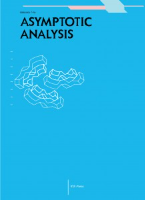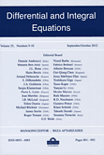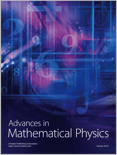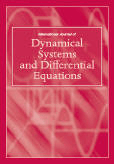
JOURNAL OF EVOLUTION EQUATIONS
Scope & Guideline
Exploring the depths of evolution equations.
Introduction
Aims and Scopes
- Mathematical Analysis of PDEs:
The journal emphasizes rigorous mathematical techniques to analyze the existence, uniqueness, regularity, and asymptotic behavior of solutions to various types of partial differential equations, including nonlinear and fractional equations. - Stochastic Evolution Equations:
There is a significant focus on stochastic evolution equations, exploring their well-posedness, stability, and the impact of stochastic perturbations on the dynamics of solutions. - Nonlocal and Fractional Dynamics:
The journal also covers nonlocal and fractional differential equations, which are increasingly relevant in modeling complex phenomena in physics, biology, and finance. - Control Theory and Optimization:
Research on control theory, including observability, controllability, and stabilization of dynamical systems, is a core area, addressing both theoretical and applied aspects. - Applications in Physical Sciences:
The journal publishes studies that connect mathematical theories with real-world applications, such as fluid dynamics, biological systems, and materials science, showcasing the interplay between mathematics and other disciplines.
Trending and Emerging
- Nonlinear Dynamics and Stability:
There is an increasing focus on understanding the nonlinear dynamics of various systems, particularly in relation to stability analysis, blow-up phenomena, and bifurcation theory. - Applications of Machine Learning and Data-driven Models:
Emerging research is beginning to incorporate machine learning techniques to analyze and solve evolution equations, highlighting the intersection of computational mathematics and data science. - Interdisciplinary Approaches:
The journal is witnessing a trend towards interdisciplinary research that combines mathematical modeling with applications in biology, physics, and engineering, fostering collaborations across disciplines. - Advanced Numerical Methods:
There is a growing interest in developing and analyzing advanced numerical methods for solving evolution equations, particularly in high-dimensional spaces and complex geometries. - Fractional Calculus and Nonlocal Effects:
Research exploring fractional calculus and nonlocal effects is on the rise, as these concepts provide new insights into modeling phenomena that exhibit memory and spatial heterogeneity.
Declining or Waning
- Classical Solutions to PDEs:
There has been a noticeable shift away from studies focused solely on classical solutions to PDEs, as more researchers are exploring weak, generalized, or stochastic solutions, reflecting an evolution towards more complex and realistic models. - Static or Time-independent Models:
The interest in purely static models has decreased, as the trend moves towards dynamic models that incorporate time-dependent behaviors and interactions, particularly in fields like fluid dynamics and population dynamics. - Local Existence Results:
Research emphasizing local existence results for solutions is becoming less frequent, with a growing preference for global existence and asymptotic analysis, indicating a shift towards more comprehensive studies.
Similar Journals

ASYMPTOTIC ANALYSIS
Shaping the Future of Mathematics through Asymptotic ResearchASYMPTOTIC ANALYSIS, published by IOS PRESS, is a leading international journal dedicated to the field of mathematics, specifically focusing on asymptotic methods and their applications across various mathematical disciplines. Established in 1988, this journal has established a strong reputation, achieving a Q1 category in 2023 within the miscellaneous mathematics category, indicating its significant impact and recognition in the academic community with a Scopus rank of 120 out of 399. With a commitment to advancing theoretical knowledge and fostering mathematical innovation, ASYMPTOTIC ANALYSIS serves as an essential resource for researchers, professionals, and students alike, facilitating the dissemination of groundbreaking findings and methodologies. Although the journal does not currently offer open access, it continuously strives to maintain high editorial standards and broaden the accessibility of its content. With its focus on critical aspects of mathematics, ASYMPTOTIC ANALYSIS will surely remain at the forefront of scholarly exchange, influencing future research directions and educational practices in the mathematical sciences.

Differential Equations & Applications
Innovating Insights in Differential Equations ResearchDifferential Equations & Applications is a distinguished academic journal published by ELEMENT, focusing on the ongoing advancements in the field of differential equations and their applications across various scientific disciplines. With an ISSN of 1847-120X and an E-ISSN of 1848-9605, this journal serves as a vital platform for researchers, professionals, and students alike to present their findings and contribute to the expanding knowledge base within this critical area of mathematics. Although currently a subscription-based publication, it provides comprehensive access to high-quality peer-reviewed articles that rigorously explore both theoretical and practical aspects of differential equations. The journal aims to foster collaboration and dissemination of knowledge, enhancing the understanding of complex systems modeled by differential equations. As it continues to grow its impact in the scholarly community, Differential Equations & Applications stands as a valuable resource for anyone engaged in mathematical research and its applications in scientific endeavors worldwide.

Evolution Equations and Control Theory
Advancing the Frontiers of Mathematical Control.Evolution Equations and Control Theory is a prestigious academic journal published by the Amer Institute Mathematical Sciences (AIMS), focusing on the intersection of applied mathematics, control theory, and simulation models. With a commendable track record since its inception in 2012, the journal has quickly established itself as a leading resource for researchers and practitioners in the fields of applied mathematics and control systems, as evidenced by its Q1 ranking in multiple categories for 2023. The journal features rigorous peer-reviewed articles that explore significant theoretical advancements and practical applications in evolution equations and their control. Although it operates under a subscription model, the high impact of research published in this journal, including its Scopus rankings—placing it within the top percentiles in related disciplines—makes it an essential read for those advancing knowledge in this vital area of study. Based in the United States, the journal continues to foster global academic discourse, driving innovation and development in evolving mathematical frameworks.

COMMUNICATIONS ON PURE AND APPLIED ANALYSIS
Elevating the Standards of Mathematical ScholarshipCOMMUNICATIONS ON PURE AND APPLIED ANALYSIS, published by the American Institute of Mathematical Sciences (AIMS), is a pivotal journal that serves the fields of pure and applied mathematics. With an ISSN of 1534-0392 and an E-ISSN of 1553-5258, this journal showcases rigorous research findings that span a myriad of topics within mathematical analysis and its applications. Given its impressive Q2 ranking in both Analysis and Applied Mathematics categories, it is recognized for its significant contributions, ranking 92nd out of 193 in Analysis and 369th out of 635 in Applied Mathematics according to Scopus. The journal, running continuously from 2004 to 2024, invites submissions that push the boundaries of mathematical thought and practice. While it operates under a traditional access model, the journal's comprehensive scope and burgeoning impact factor underscore its importance for researchers, professionals, and students who seek to engage deeply with current mathematical advancements.

ZEITSCHRIFT FUR ANALYSIS UND IHRE ANWENDUNGEN
Unveiling New Perspectives in Analysis and Its ApplicationsZEITSCHRIFT FUR ANALYSIS UND IHRE ANWENDUNGEN, published by the European Mathematical Society, stands as a vital resource in the fields of analysis and applied mathematics. With an ISSN of 0232-2064 and E-ISSN 1661-4534, this esteemed journal has been disseminating high-quality research since its inception in 1996, converging its efforts through 2024. Recognized within Q2 quartiles of both analysis and applied mathematics categories, it ranks #98 out of 193 in Mathematics _ Analysis and #379 out of 635 in Mathematics _ Applied Mathematics according to Scopus, affirming its significant impact within the academic community. Although not open access, the journal provides a platform for rigorous peer-reviewed articles that foster the interplay between theoretical insights and practical applications, catering to the needs of researchers, professionals, and students alike. With its editorial board comprised of leading experts, ZEITSCHRIFT FUR ANALYSIS UND IHRE ANWENDUNGEN continues to advance mathematical knowledge, making it an essential journal for those aiming to stay at the forefront of analysis and its applications.

Dynamics of Partial Differential Equations
Connecting Researchers in the World of Differential EquationsDynamics of Partial Differential Equations is a prestigious peer-reviewed journal published by INT PRESS BOSTON, INC in the United States, specializing in the intricate and innovative field of partial differential equations (PDEs). With an ISSN of 1548-159X, this journal has become an invaluable resource for researchers, professionals, and students alike since its inception in 2007. The journal is recognized for its rigorous scholarship, as indicated by its 2023 category quartiles, achieving Q1 status in Analysis and Q2 in Applied Mathematics. The Scopus rankings further affirm its relevance, placing it within the top half of its field. While the journal operates under a subscription model, it remains a vital platform for disseminating cutting-edge research that addresses both theoretical and applied aspects of differential equations, contributing significantly to advancements in mathematics and related disciplines. It serves as a meeting ground for researchers dedicated to exploring the dynamic and evolving nature of PDEs, fostering collaboration and innovation within the academic community.

Differential and Integral Equations
Shaping the Future of Applied MathematicsDifferential and Integral Equations is a renowned peer-reviewed journal published by KHAYYAM PUBL CO INC, focusing on the rich and expanding field of mathematical analysis and applied mathematics. With its ISSN 0893-4983, this journal serves as a critical platform for disseminating innovative research, particularly in the areas of differential and integral equation theory and its applications across various scientific disciplines. Maintaining a significant presence in the academic community, it ranks in the Q2 category for both Analysis and Applied Mathematics as of 2023, highlighting its impact and relevance. The journal's indexed rankings place it at the 67th percentile in Mathematics - Analysis and the 54th percentile in Mathematics - Applied Mathematics, further establishing it as a valued resource for emerging researchers and established professionals alike. Although open access is not currently available, the journal remains crucial for those seeking to contribute to and stay informed on advancements in differential equations and their applications, with converged publication years from 1988 to 1995, 2009 to 2014, and continuing through 2016 to 2024. Researchers, professionals, and students will find that this journal provides essential insights and fosters collaboration within the dynamic mathematical community.

Advances in Mathematical Physics
Advancing Knowledge through Open AccessAdvances in Mathematical Physics is a premier open-access journal published by HINDAWI LTD, dedicated to the dissemination of research in the fields of applied mathematics and physics. With its ISSN 1687-9120 and E-ISSN 1687-9139, this journal has been a vital platform for innovative studies since its inception in 2009, fostering a collaborative environment for researchers and professionals alike. The journal features a wide range of topics, including but not limited to mathematical models, computational physics, and interdisciplinary applications, thus attracting a diverse readership. Ranked in the Q3 quartile for both Applied Mathematics and Physics and Astronomy, it serves as a significant resource for academics looking to explore cutting-edge developments and theoretical advancements. With an emphasis on open accessibility, Advances in Mathematical Physics ensures that research findings are readily available to the global academic community, leveling the playing field for emerging scholars and seasoned researchers. By consistently showcasing high-quality manuscripts, the journal contributes substantially to the fields of mathematics and physics, encouraging scholarly dialogue and advancing knowledge across a myriad of applications.

Differential Equations and Dynamical Systems
Challenging Paradigms, Inspiring InquiryDifferential Equations and Dynamical Systems is a prominent academic journal published by Springer India, dedicated to the fields of analysis and applied mathematics. With an ISSN of 0971-3514 and an E-ISSN of 0974-6870, this journal serves as a platform for scholars to disseminate innovative research on differential equations and their applications in various dynamical systems. Recognized within the Q3 category for both Analysis and Applied Mathematics, it ranks impressively in Scopus, highlighting its contribution to the advancement of mathematical sciences. The journal aims to foster interdisciplinary research and provide an inclusive forum for researchers, professionals, and students engaged in this vital area of study. Although not open access, it offers valuable insights and findings published from 2008 to 2024, reinforcing its importance as a resource for ongoing developments in mathematical analysis. As a reputable source in its field, it invites contributions that challenge existing paradigms and inspire further inquiry.

International Journal of Dynamical Systems and Differential Equations
Exploring the Frontiers of Mathematical SciencesThe International Journal of Dynamical Systems and Differential Equations, published by INDERSCIENCE ENTERPRISES LTD, is an esteemed academic journal that focuses on the intricate mathematical theories and applications of dynamical systems and differential equations. Established in the United Kingdom, this journal plays a critical role in advancing research within its scope, which includes control optimization, discrete mathematics, and engineering. Despite its recent rankings indicating a Q4 status in Control and Optimization and Discrete Mathematics, along with a Q3 position in Engineering, the journal provides a vital platform for scholars to disseminate their findings and engage with ongoing debates in these fields. Researchers and students alike benefit from the journal's commitment to fostering innovative ideas and methodologies, contributing to the development of mathematical sciences. Although currently not an open-access publication, the journal's archives from 2007 to 2023 include valuable research articles that continue to influence the landscape of mathematical explorations.